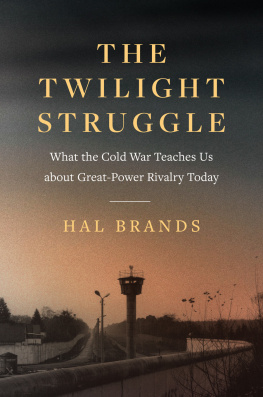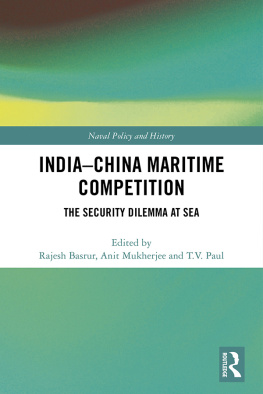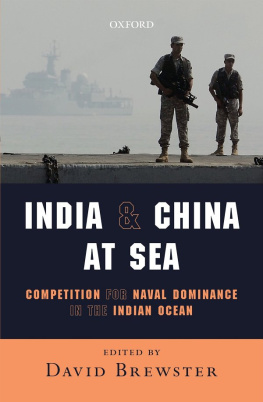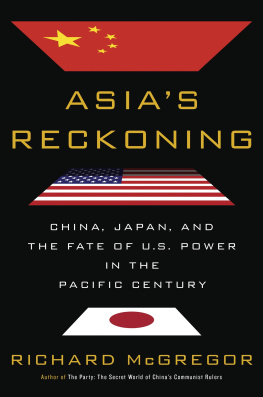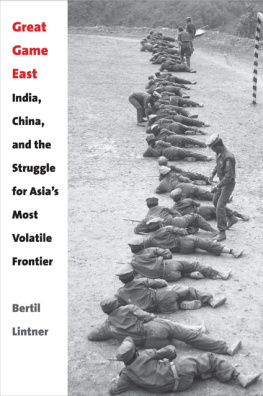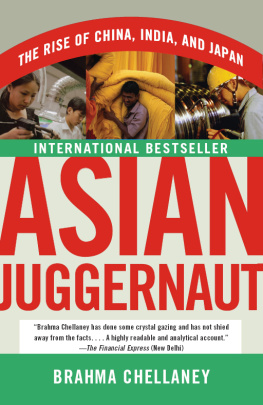HARCOURT, INC. ORLANDO AUSTIN NEW YORK SAN DIEGO LONDON
Copyright 2008 by Bill Emmott
All rights reserved. No part of this publication may be reproduced or
transmitted in any form or by any means, electronic or mechanical,
including photocopy, recording, or any information storage and
retrieval system, without permission in writing from the publisher.
Requests for permission to make copies of any part of the work
should be submitted online at www.harcourt.com/contact or mailed
to the following address: Permissions Department, Houghton Mifflin
Harcourt Publishing Company, 6277 Sea Harbor Drive, Orlando,
Florida 32887-6777.
www.HarcourtBooks.com
Library of Congress Cataloging-in-Publication Data
Emmott, Bill.
Rivals: how the power struggle between China, India and Japan
will shape our next decade/Bill Emmott.1st ed.
p. cm.
Includes bibliographical references and index.
1. AsiaForeign relations. 2. Balance of power.
3. International relations. I. Title.
JZ1720.E52 2008
327.1'12095dc22 2007052804
ISBN 978-0-15-101503-0
Text set in AGaramond
Designed by April Ward
Printed in the United States of America
First edition
K J I H G F E D C B A
FOR CAROL
CONTENTS
1. ASIA'S NEW POWER GAME
2. A CONTINENT CREATED
3. CHINA: MIDDLE COUNTRY, CENTRAL ISSUE
4. JAPAN: POWERFUL, VULNERABLE, AGING
5. INDIA: MULTITUDES, MUDDLE, MOMENTUM
6. A PLANET PRESSURED
7. BLOOD, MEMORY AND LAND
8. FLASH POINTS AND DANGER ZONES
9. ASIAN DRAMA
ACKNOWLEDGMENTS
ENDNOTES
BIBLIOGRAPHY
INDEX
A NOTE ON NAMES
ASIAN NAMES CAN BE CONFUSING because of varying practices of Westernization. In this book, Chinese names are given in the standard Chinese order, with family name first and given name second, as in Deng Xiaoping. Some Chinese people, in particular those working in Western institutions, follow the Western naming order, but this is not yet standard practice. For Japanese names, however, the Western order is used virtually universally when dealing with foreigners, and so that is followed here: e.g., Junichiro Koizumi, where Koizumi is the family name. For Korean names, the family name is used first, as in Kim Jong-il. In Singapore, for people of Chinese extraction (such as Lee Kuan Yew), the Chinese naming order is used; for others, such as Kishore Mahbubani, the Western order is used. For Indians, the given name is first and the family name is second.
1. ASIA'S NEW POWER GAME
FEW OF HIS CONTEMPORARIES think of George Walker Bush as a visionary American president unless they are using the term to imply a touch of madness. Such is the legacy of his misadventure in Iraq, of the continued instability in Afghanistan, of the worldwide decline in the reputation of the United States during his administration, that many would rank him as having been the worst American president since Richard Nixon (196974), or Herbert Hoover (192933), or even, for his harshest critics, since the founding of the republic. It has not been for want of ambition. In the two years following the terrorist attacks of September 11, 2001, President Bush appeared to form the grandest of grand foreign-policy strategies, seeking nothing less than a transformation of the Middle East and Central Asia, the regions from which the terrorism seemed to have originated, with democracyor at least accountabilityreplacing dictatorship. John Lewis Gaddis, a Yale professor of grand strategy and the doyen of cold-war historians, described this as "the most fundamental reassessment of American grand strategy in half a century."
Except in one respect. That respect represents one of the few points of continuity between the Bush administration's first few months in office, when a rising China had been considered America's principal foreign-policy concern, and the post-September n world. In September 2002 the Bush administration stated that one of its aims would be to "extend the peace by encouraging free and open societies on every continent." Early in his second term, George Bush sought to do just that, in the most rapidly changing continent of all, the one that is home to half the world's population and to its fastest-developing economies: Asia. He did it by launching a bold initiative to try to establish closer American ties with the world's biggest democracy, India.
That act may eventually be judged by historians as a move of great strategic importance and imagination. It recognized that while al-Qaeda and its sort pose the biggest short- and, perhaps, medium-term challenge to America, in the long term it is the expected shift in the world's economic and political balance toward Asia that does promise, as the Bush team originally thought, to have the greatest significance. It was the culmination of a process that was begun by his then-new secretary of state, Condoleezza Rice, on a visit to Delhi in March 2005, and was sealed by President Bush himself during his own visit to India exactly a year later. With India's professorial prime minister, Manmohan Singh, President Bush signed a deal to cast aside forty years of hostility and suspicion between the two countries, ending almost a decade of tension over India's 1998 nuclear-weapons tests, by agreeing to commence collaboration over civil nuclear energy and to sweep aside decades of practice in nuclear nonproliferation agreements. India was being made a very special case, in a manner designed to help boost both its economic strength and its military capacity. And that exception was being made for a very special reason: the rise of China.
China is used to being treated as a special case. Richard Nixon's presidency was dominated at the time by the final failed years of the Vietnam War and by Watergate, but memories of it now are dominated by a diplomatic act, not a military or judicial one: his dramatic opening of relations with China in 197172, which brought to an end more than two decades of bitter estrangement between the United States and the People's Republic. Watergate may have given us a suffix to be attached to each and every scandal that occurs in Washington, but the opening to China has lived on even more strongly in the imagination, yielding operas, plays and books, as well as a term ( Nixon-to-China) now generically used to denote a meeting of minds between political extremes. Shocking though it seemed at the time, with hindsight Nixon's courting of Mao Zedong and his regime made perfect sense, helping to preserve and exploit the isolation of the Soviet Union. After Mao's death in 1976 and the ascent to power of Deng Xiaoping, it can even be said to have made possible the process by which China chose to emulate America's capitalist system, albeit as "socialism with Chinese characteristics" in Deng's delicious phrase, and thus to launch what we now call globalization: the huge rise in trade, investment and other forms of connectedness between almost every country in the world but especially involving the two most populous, first China and later India.
George Bush's rapprochement with India cannot rival Nixon's trip to China for its sheer shock value, nor for the drama with which it was unveiled. Indeed, its initial phase in 2005 was hardly noticed outside India. Moreover, although the 2006 nuclear pact caused an uproar in Washington and in arms-control circles in Europe, the dominant argument about it concerned an issue too arcane to catch the public imagination: namely, the effect of the deal on the global regime designed to prevent the spread of nuclear weapons. Nor was the rapprochement entirely new, for it built on discussions begun almost a decade earlier by President Bill Clinton's administration, and especially by his deputy secretary of state, Strobe Talbott. But the final step taken by the Bush administration was a big one, a step that his predecessor had not been willing to take.
Next page


